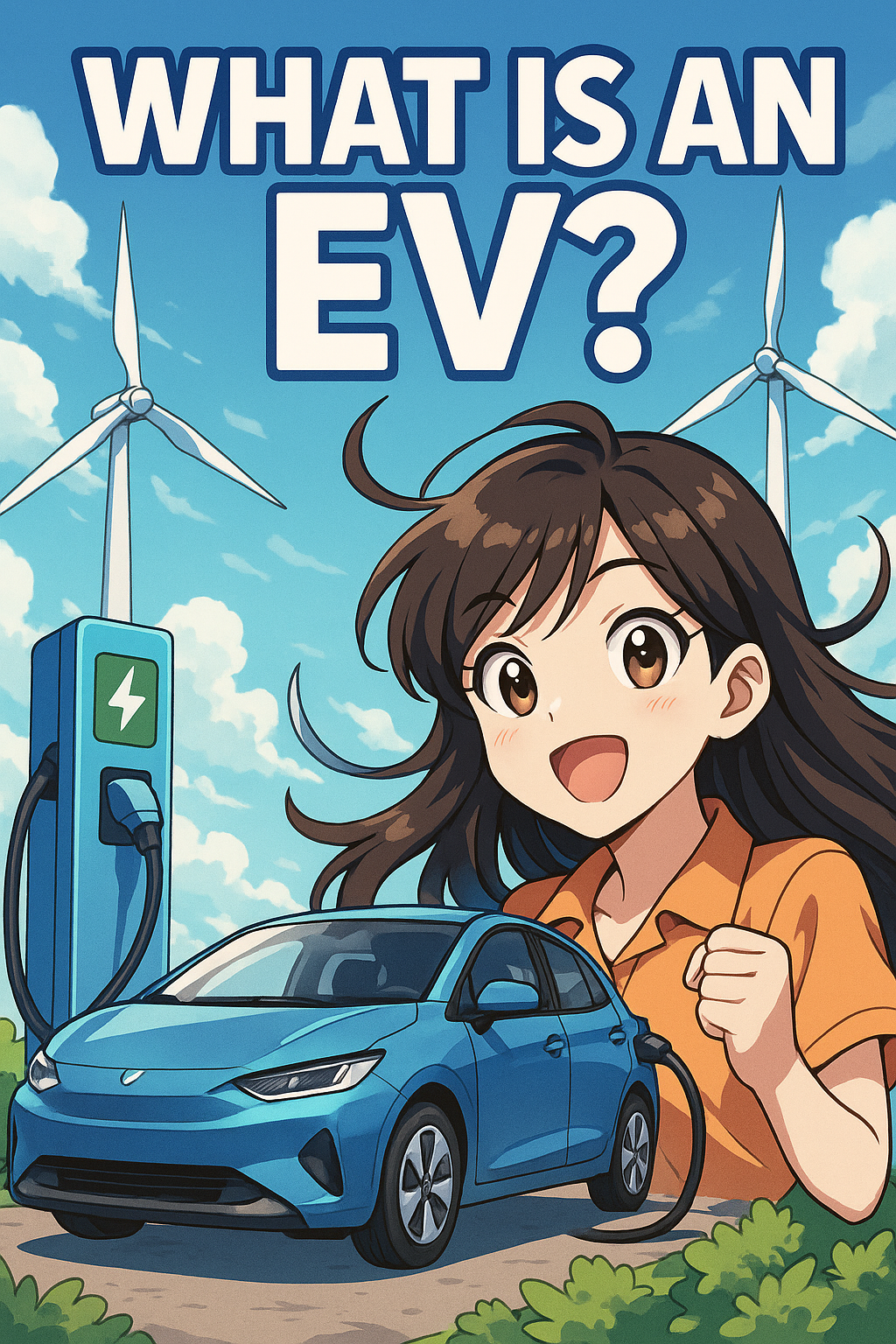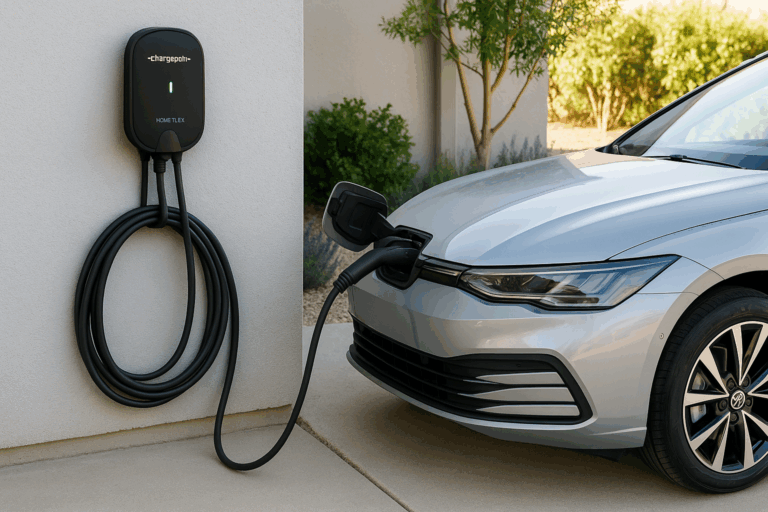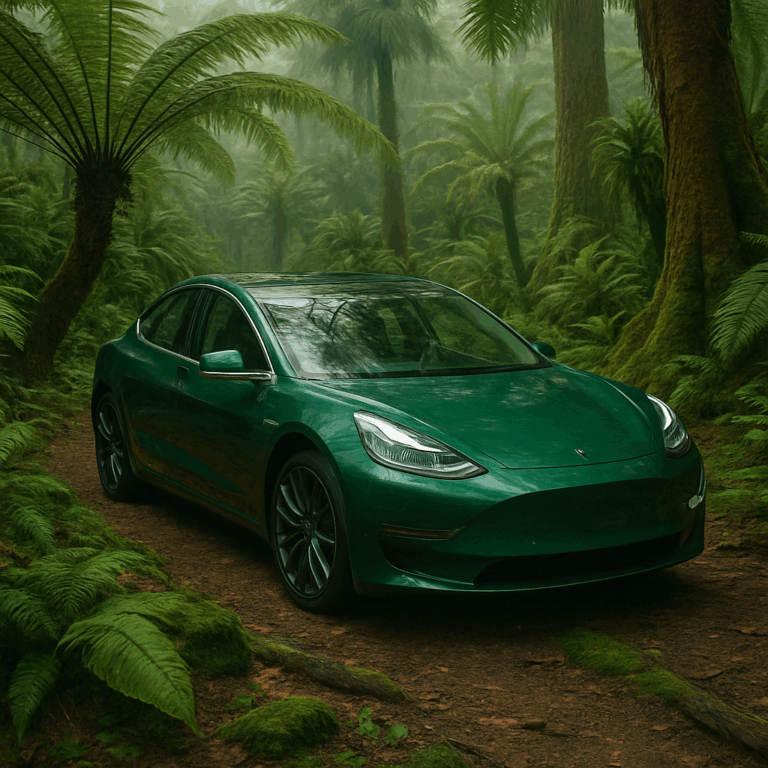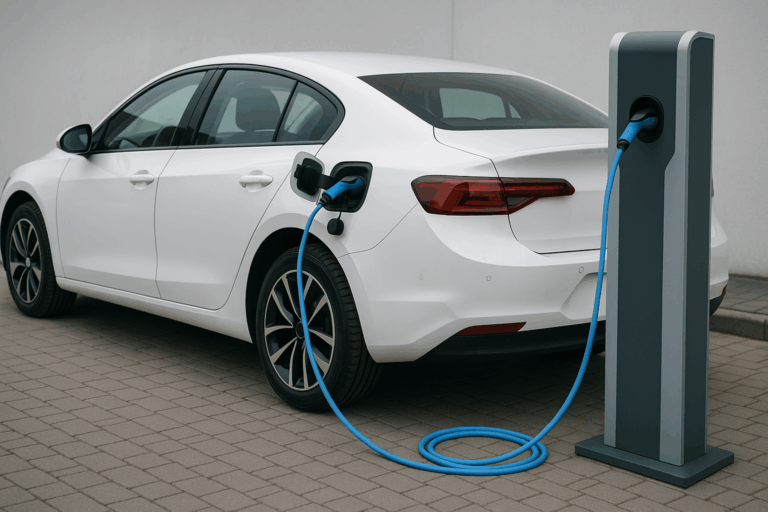Electric Vehicles 101: A Millennial’s Guide to EVs in 2025
Electric cars are no longer futuristic fantasies – they’re here, they’re trending, and they might even be your next car. For millennial drivers in Europe, 2025 is shaping up to be the year electric vehicles (EVs) hit the mainstream. But what exactly is an EV, and how is it different from the gas-guzzlers we grew up with? In this easy-to-read guide, we’ll break down how EVs work, how they compare to hybrids and traditional cars, why everyone is talking about them in 2025, and which models give you the best bang for your buck.
What Is an EV and How Does It Work?

An Electric Vehicle (EV) is a car that runs on electricity instead of petrol or diesel. Think of it as a giant rechargeable gadget on wheels – kind of like your smartphone, but for getting you to work or class. Here’s the simple breakdown of how an EV works under the hood:
- Battery Pack: EVs carry a large battery (usually lithium-ion, like the one in your phone) that stores electrical energy. This battery is the EV’s “fuel tank.” You charge it by plugging the car into electricity – either at home or at public charging stations.
- Electric Motor: Instead of an engine with pistons and fuel explosions, EVs use an electric motor to turn the wheels. In a gas car, fuel and air ignite in an internal combustion engine (ICE) to create motion. In an EV, there’s no combustion at all – the electric motor uses electromagnets and current from the battery to spin the axle . The result? A much simpler drive system with instant power delivery.
- Inverter: The battery provides direct current (DC) electricity, but the motor typically runs on alternating current (AC). An inverter acts as the translator, converting DC from the battery into AC for the motor . It’s a bit technical, but essentially the inverter ensures the motor gets the right kind of juice.
- Regenerative Brakes: EVs also have a cool trick – when you brake or coast, the electric motor can work in reverse to generate electricity, feeding a bit of power back into the battery. It’s like recycling energy that would be wasted as heat in a normal car’s brakes.
All these pieces work together seamlessly. You press the accelerator, electricity flows from the battery to the motor, and the car moves silently and smoothly – no engine rumble. Take your foot off, and the EV slows down, possibly recharging a smidge. It’s a very “point-and-shoot” driving experience: simple, quick, and responsive. And because there’s no traditional engine, EVs don’t need things like oil changes or mufflers, which means less maintenance fuss for you.
EV, Hybrid, or Gas: What’s the Difference?
You’ve heard the buzzwords: electric cars, hybrids, plug-in hybrids, gas cars… what does it all mean? Let’s break down the key differences in plain English:
- Battery Electric Vehicle (BEV or just “EV”): This is a fully electric car – it has no petrol engine at all. It runs purely on electricity stored in a battery and has zero tailpipe emissions (no smoke or CO2 coming out the back). You charge it up, and drive away on electric power only. Examples: Tesla models, Nissan Leaf, Volkswagen ID series.
- Hybrid (HEV): A hybrid car has both a petrol engine and a small electric motor/battery. The two work together for better fuel efficiency. You cannot plug a standard hybrid in – the battery is charged by the engine and regenerative braking. The electric motor mainly assists the engine (for example, giving an extra boost or allowing very short electric-only creeps in traffic) . The petrol engine is still the primary source of power, so hybrids do have emissions. Example: Toyota Prius (classic hybrid).
- Plug-In Hybrid (PHEV): Think of this as a hybrid on steroids. A PHEV also has both engine and electric motor, but with a larger battery that you can plug in and charge. This gives a plug-in hybrid an electric-only driving range of anywhere from ~40 to 80 km (perfect for short commutes). After the battery depletes, the petrol engine takes over and the car behaves like a normal hybrid. PHEVs have a foot in both worlds – you can do daily trips on electric power (if you charge up), but you have a fuel engine for longer trips so you don’t have to worry about finding a charger mid-journey.
- Gas-Powered Car (ICE Vehicle): The traditional car most of us grew up with – it has an internal combustion engine that runs on petrol or diesel. You refuel at gas stations. It has many moving parts (engine cylinders, valves, exhaust system, etc.), and it emits exhaust gases (CO2, nitrogen oxides, etc.) out of the tailpipe as a result of burning fuel. These cars tend to be cheaper to buy upfront, but you pay more in fuel and maintenance over time (oil changes, timing belts, spark plugs – the list goes on).
In a nutshell: Electric cars use electricity only and have no emissions while driving. Hybrids mix a petrol engine with a dab of electric assist to save fuel (but can’t go very far on electricity alone, if at all). Plug-in hybrids give you a taste of EV life with short electric range, plus a gasoline safety net. And gas cars are the traditional engine-only vehicles with the lowest fuel efficiency and highest emissions among these types. Each has its pros and cons, but as we’ll see, the trend is heavily toward ditching the dinosaur juice in favor of electrons.
Why EVs Are Trending in 2025

You might be noticing a lot more EVs on the streets lately – and it’s not just your imagination. Electric vehicles are trending globally in 2025 for a bunch of reasons that hit all the right notes: technology, economics, policy, and plain old planet-saving. Here’s why EVs are having a major moment:
- Tech Improvements (Bye-Bye, Range Anxiety): EV technology has improved dramatically in the past few years. Batteries are getting more efficient and cheaper, so newer electric cars can drive much farther on a charge than older models. For instance, the average battery electric car sold in Europe in 2023 could go about 430 km on a full charge – and high-end models can exceed 500-600 km. Charging has gotten faster, too. Many cars can charge from 10% to 80% in around 20-30 minutes at a high-speed charger – perfect for a quick break on a road trip. With each new model release, EVs become more practical, easing the old “range anxiety” fears. In 2024 alone, 24 new electric car models were launched globally, giving consumers more choices than ever . This means whether you want a compact city car or a roomy SUV, there’s likely an EV option for you with the latest tech (touchscreens, driver assists, you name it).
- Price Drops and Best Value Models: Remember when flat-screen TVs cost a fortune until suddenly they didn’t? A similar thing is happening with EVs. As battery costs come down and production scales up, electric cars are inching closer to price parity with gas cars. In China, EVs have already become extremely price-competitive with gas vehicles , driving massive adoption. In Europe, many countries offer incentives that effectively discount the price of a new EV – for example, France has offered up to a €7,000 bonus for EV buyers and Germany around €6,000-9,000 in recent years (though some subsidies are now tapering off) . The result: sales are booming. Over 17 million electric cars were sold worldwide in 2024, a 25% jump over 2023 . In Europe, about one in five new cars sold in 2024 was electric . That’s huge – it means what used to be niche is now practically normal. By the end of 2024, the global EV fleet hit 58 million cars on the road (around 4% of all cars) . In other words, EVs are going mainstream, and growing competition is starting to bring prices down to earth.
- Policy and Government Push: Governments want cleaner transportation, and they’re using both carrots and sticks to make it happen. Across Europe, there are strong policies pushing drivers and automakers toward electric. The EU has set a 2035 deadline to reach 100% zero-emission new cars – effectively a ban on new petrol/diesel car sales after that . That looming cutoff is a big deal: carmakers know they have to heavily ramp up EV offerings now to hit the targets. Some countries are even more aggressive; Norway, for example, has used tax breaks and perks so effectively that over 88% of new cars sold there in 2024 were electric! Other European countries offer perks like tax breaks, rebates, and even free parking or use of bus lanes for EV drivers. On the flip side, cities are beginning to restrict or charge fees for gas-burning cars (think London’s ULEZ or Paris’s low-emission zones). In short, policymakers are nudging – and sometimes shoving – people toward EVs with legislation. Even the UK, after 2030, will ban new purely gasoline cars (allowing only hybrids until 2035). All these rules and incentives make EVs a smarter long-term bet, especially if you plan to keep a car for many years.
- Climate Awareness and Environment: Let’s not forget the “why” behind those policies – climate change and air quality. Driving an EV means zero tailpipe emissions on the road, which is great for cutting urban air pollution and smog. Globally, there’s a growing awareness among millennials and Gen Z that choosing an electric car is one way to personally reduce your carbon footprint. Transportation is a significant chunk of greenhouse gas emissions, so cutting out petrol is a meaningful step toward climate goals. Europe has committed to climate neutrality by 2050, and slashing transport emissions is vital to get there . We’ve all seen the wildfires, heatwaves, and climate protests – the pressure is on to adopt cleaner tech. Many young adults feel good about driving electric because it aligns with their values of sustainability. (Plus, who doesn’t like the idea of sticking it to Big Oil just a little?) While it’s true that EV batteries require mining of materials and manufacturing that has its own environmental impact, studies generally find EVs have lower overall emissions over their lifetime than equivalent gas cars, especially as Europe’s electricity grid gets greener every year . In 2025, this eco-conscious mindset is a big factor in the EV trend.
- Cool Factor and Innovation: Last but not least, EVs are kinda cool now. They’re packed with tech features that appeal to the smartphone generation. Many EVs come with large touchscreens, over-the-air software updates, advanced driver assist systems, and connected apps that let you remote-start or preheat the car from your phone. They often feel like gadgets as much as vehicles. Tesla, for instance, made a name for itself not just with electric drive but with features like Autopilot, a minimalist interior, and even in-car video games. This tech-forward vibe resonates with millennials. Driving an EV can feel like being part of the future – and let’s admit, silently zipping away from a traffic light with instant torque feels a bit like a superpower. 🚀 The social cachet of owning an EV (and the curiosity it sparks among friends and family) doesn’t hurt either. It’s 2025 – owning an electric car signals that you’re living in the modern era, and that’s a flex many are happy to embrace.
Best Electric Cars in Europe (2025): Popular & Best-Value EVs
So you’re sold on the idea of an electric ride – but which one to get? The great news is that in 2025, European buyers have more options than ever, from affordable city cars to high-performance luxury EVs. Below is a roundup of some of the most popular and best-value electric cars you can buy in Europe right now:
Volvo EX30, a compact electric SUV, was a surprise hit in Europe – it became the third best-selling EV of 2024 with over 78,000 sold . Its blend of premium feel and affordability (prices start ~£33k in the UK) has resonated with many first-time EV buyers.
- Tesla Model Y – The Trendsetter: Tesla’s mid-size SUV is Europe’s best-selling EV (over 209,000 sold in 2024) . Millennials love the Model Y for its mix of tech, space, and performance. It’s a crossover with a long driving range (~430 km on the base model) and a fast-charging network (Tesla’s Superchargers) that makes long trips easy. Starting around €45,000, it’s not the cheapest, but you get a high-tech, Autopilot-capable vehicle that’s as much gadget as car.
- Tesla Model 3 – The Slick Sedan: The Model Y’s sleeker sibling, the Tesla Model 3, is a compact sedan that’s been a global EV icon. It was Europe’s second most popular EV in 2024 . The Model 3 offers a sporty drive, a minimalist interior with that signature big touchscreen, and range of about 500+ km for the Long Range version. After Tesla’s price cuts, you can snag a base Model 3 for around €40,000 in Europe, making it a compelling alternative to BMWs and Audis. Plus, you’ll never need to visit a petrol station – just plug in at home or work.
- Volvo EX30 – Premium Feel, Starter Price: The EX30 is Volvo’s newest compact SUV and it’s been turning heads. In its first year on the market, it shot up to third place in Europe’s EV sales (overtaking some veteran models) . Why so popular? It packs Volvo’s Scandinavian cool design and top safety features into a smaller, more affordable package – prices start under €35k for a stylish SUV that can go up to ~475 km on a charge. It’s also quick and nimble to drive. Essentially, the EX30 made luxury EV features accessible to a wider audience, and Europeans responded with their wallets.
- Skoda Enyaq iV (and VW ID.4) – Family-Friendly SUVs: If you’re after a practical family car, look at the Skoda Enyaq iV or its cousin the Volkswagen ID.4. These are roomy, electric SUVs from the Volkswagen Group, with the Enyaq being one of Europe’s EV success stories. In 2024 the Enyaq notched around 69,000 sales , proving demand for mainstream-brand EV SUVs is strong. Both ID.4 and Enyaq offer solid range (around 400-500 km, depending on battery options), comfortable cabins, and family-oriented practicality. They start around €40,000-€45,000. Think of them as the electric equivalents of the VW Tiguan or Skoda Kodiaq – plenty of space for kids and luggage, but with a quiet electric powertrain and lower running costs.
- MG4 – Budget Hatchback Champion: The MG4 is an example of how far affordable EVs have come. MG (a historic British badge now owned by a Chinese company) has been making waves by offering low-cost electric models with good specs. The MG4 is a compact hatchback that undercuts most rivals on price – starting around £26k in the UK (≈€30k) – yet delivers ~350 km of range in real conditions and a fun driving experience. It’s no frills on the luxury front, but it does have modern features (like adaptive cruise and a decent infotainment system). For millennials who want a new EV without breaking the bank, the MG4 is one of the best-value choices.
- Citroën e-C3 – Electric for Everyone: Citroën’s mission with the e-C3 was to make EVs attainable. This small hatchback comes at a price point comparable to petrol superminis – around £22,000 in the UK (roughly €25k) for a new one. It offers about 320 km of range on a charge, which is plenty for city life and short trips. By not overloading the e-C3 with expensive gimmicks, Citroën kept costs low while covering the essentials (solid range, a comfortable ride, and a surprisingly roomy interior). The result? It’s been highly praised – in fact, the Citroën e-C3 was named “2024 Car of the Year” by a major auto publication for its excellent value. If you’re looking to go electric on a tighter budget, this is a car that says: why not now?
- Dacia Spring – Europe’s Cheapest EV: For the absolutely budget-conscious (or maybe as a second city runabout car), the Dacia Spring deserves a mention. This ultra-compact EV isn’t fast or flashy, but it is the most affordable electric car in Europe. Prices start around €15,000 (approx £15k in the UK) – and in some places, after incentives, it can cost almost peanuts (one report mentioned deals in certain countries bringing it near €11k net!). The Spring is a tiny crossover-like hatch with a modest ~230 km range and basic features. It won’t wow you with performance (it has about 45 horsepower in base trim), but it gets the job done for urban commuting. Dacia proves that EVs can be extremely cheap to buy and run – it’s a popular choice for drivers who mostly need a city car and hate paying for petrol. Just keep in mind, the low price means compromises: the Spring is very slow and has a no-frills interior, but hey, it’s as green as any EV and ridiculously cheap to own.
Of course, there are many other EVs on the market – from the Fiat 500e city car to the high-end Porsche Taycan – but the list above covers a spectrum from best-sellers to best bargains that are especially relevant in 2025. The diversity is huge now. Whether you prioritize range, luxury, price, or style, you can likely find an electric car that fits your needs.
Below is a quick comparison table of top EV models mentioned, showing their approximate range and starting price in Europe for 2025:
Top Electric Car Models (Europe 2025) – Range and Price
| Model (Type) | Driving Range (WLTP) | Starting Price* |
| Tesla Model Y (SUV) | ~430 km | ~ €45,000 |
| Tesla Model 3 (Sedan) | ~550 km | ~ €40,000 |
| Volkswagen ID.4 (SUV) | ~500 km | ~ €44,000 |
| Volvo EX30 (Compact SUV) | ~475 km | ~ €35,000 |
| MG4 (Hatchback) | ~350 km | ~ €30,000 |
| Citroën e-C3 (Supermini) | ~320 km | ~ €25,000 |
| Dacia Spring (City car) | ~230 km | ~ €15,000 |
Prices are approximate starting figures (base model) in the EU market. Actual range can vary by battery configuration; values above are typical WLTP range for the model’s popular battery option.
As you can see, EVs now span from €15k econoboxes to €45k tech-loaded family cars. Importantly, many fall in the €25k-€35k range which is similar to what millennials might pay for a new petrol car in the same segments. And remember, the total cost of ownership for an EV often ends up lower than a gasoline car’s, thanks to cheaper “fuel” (electricity) and lower maintenance – which brings us to our next section.
EV vs Gas Car: Comparing Features, Costs and Maintenance
So how does living with an EV stack up against a traditional petrol car day-to-day? Let’s compare electric vs. gas cars on the things that matter: features and driving experience, costs (both upfront and ongoing), fueling/charging, and maintenance.
Driving Experience: In an EV, the first thing you’ll notice is how quiet and smooth it is. There’s no engine noise – at low speeds you might hear a faint whir from the motor, but that’s it. Acceleration is usually brisk because electric motors deliver instant torque (no revving up needed). Even a fairly modest EV can surprise you at a traffic light with how quickly it jumps off the line. By contrast, gas cars come with the familiar engine sound and vibrations. Some folks enjoy the sound of a roaring engine, but many millennials are just as happy with the calm hum of an EV – it can make your commute feel more zen. On the highway, EVs are also quiet (no droning engine noise), so long trips can be a bit less fatiguing noise-wise. One downside: top-end speed or sustained high-speed runs can drain an EV’s battery faster, whereas a petrol car can cruise at high speed until the tank runs dry. But for typical driving, EVs often feel more responsive and easier in stop-and-go traffic. There’s no gear shifting – it’s single-speed, seamless acceleration. In short, driving an electric car feels modern and effortless, while a gasoline car gives you more mechanical feedback (which some may like, others not so much).
Features and Tech: This will vary by model, but broadly, EVs tend to be tech-forward. Many EVs were designed in the last few years and come packed with the latest gadgets and driver aids. Large digital displays, advanced infotainment, and smartphone integration are pretty much standard. Gas cars, especially older models, might lack some of these high-tech touches unless you’re buying a recent redesign. That said, feature-for-feature, an EV and a gas car from the same brand will often offer similar comforts (automatic climate control, GPS, etc.). One interesting difference is cabin heating: EVs don’t have waste engine heat to warm the cabin, so they use electric heaters or heat pumps – meaning using the heater heavily can reduce your range a bit. Gas cars get heat “for free” from the engine, ironically. On the flip side, an EV can pre-warm or pre-cool the cabin while plugged in, using an app, so you can always step into a perfect temperature car without idling an engine.
Upfront Cost: This has been a sticking point – EVs tend to cost more to buy new than equivalent gas cars. The battery is the expensive part. However, the gap is narrowing. In 2025, you can find electric models with starting prices comparable to popular gas models, especially when incentives are considered. For example, a VW ID.3 (electric hatchback) might be only a few thousand euros more than a VW Golf (petrol hatchback) on paper, and if your country gives a rebate, it could even be similar or less. Generally, expect to pay a bit more upfront for an EV – maybe an extra €5k-€10k over a similar gas car’s sticker price. The good news is that over time, EVs can save you money. Electricity is cheaper per kilometer than petrol in most countries, and EVs qualify for tax breaks or lower road taxes in many regions. Plus, fewer moving parts means fewer things to break. A European study noted that even though an EV’s purchase price is higher, it’s often cheaper over time due to lower maintenance and charging costs. So, while you might shell out more on day one, you could come out ahead after years of not buying petrol and visiting service shops less often.
Fuel vs Charging (Convenience and Cost): Gas cars have the advantage here in terms of speed of refueling – there’s no way around it. Filling a petrol tank takes 5 minutes at a station, giving you another 600-800 km of range. Charging an EV, on the other hand, takes longer. If you’re at a fast DC charger, many EVs can get ~80% charged in about 30 minutes. That’s impressive compared to a few years ago, but it’s still a coffee break, not a quick splash-and-go. At home or on slower chargers, it can take several hours to fully charge a depleted battery – typically you’d just plug in overnight, and by morning your car’s ready. The key difference in mindset: with an EV, you “refill” when the car is parked (at home, work, shopping center), rather than making special trips to a fuel station. This actually adds convenience for daily life – imagine never having to stop for gas on your weekly routine. You leave home every day with effectively a “full tank.” However, on a road trip, you will need to plan charging stops. Europe’s charging infrastructure is growing fast (you’ll find fast chargers along all major highways now), but it’s not as ubiquitous as gas stations, and in rural areas you might have to go a bit out of your way to find a charger. Charging cost is generally much lower than fuel cost: charging at home might be only €5-10 for a full charge (depending on electricity rates and battery size), which could be a quarter of what the equivalent petrol would cost for the same mileage. Even public fast chargers, which charge a premium for the convenience, tend to be cheaper than petrol per km – though in some countries with high electricity prices or if using ultra-fast premium networks, the cost per km can inch closer to a petrol car. Overall, most EV owners save a lot on “fuel.” In 2025, with energy prices in flux, the exact savings vary, but as a rule of thumb: driving on electricity costs significantly less than driving on petrol for the same distance. Plus, you can fuel your car from the comfort of home – something gas car owners can only dream about.
Maintenance: Here’s a big perk of EVs that doesn’t get enough attention – they are much simpler machines mechanically. An electric motor has maybe a dozen moving parts, while a combustion engine has hundreds. There’s no engine oil to change, no spark plugs or fuel filters, no exhaust muffler or catalytic converter, no timing belts. As a result, routine maintenance on EVs is minimal. You’ll rotate tires, refill wiper fluid, change cabin air filters, and eventually replace brake pads and tires – but brake pads last longer in EVs thanks to regenerative braking doing a lot of the work (some EV drivers go 5+ years without a brake job). According to one explainer, the simpler tech in EVs means less risk of things breaking down and fewer trips to the garage, compared to combustion engines. Of course, EVs aren’t maintenance-free: you might have to replace the battery coolant every so many years, and you need to keep the battery healthy. The biggest maintenance concern – or rather, long-term concern – is the battery. Batteries do degrade over many years, and if you keep a car 10-15 years you might see some range loss. However, manufacturers typically warranty EV batteries for 8 years or ~160,000 km, and it’s not uncommon for batteries to last well beyond that with, say, 90% of their original capacity. In any case, EVs won’t need those annual engine tune-ups. In contrast, gas cars will need regular oil changes (usually every 10-15k km), periodic transmission service, exhaust system fixes as they rust, etc. This maintenance adds up in cost and inconvenience – costs that EV owners largely avoid. One caveat: if something does go wrong with the EV battery or motor, repairs can be expensive, but such failures are statistically rare. Overall, EVs are cheaper and easier to maintain on average than gas cars, which means more money in your pocket (and more time not spent at the mechanic).
Environmental Impact: We touched on this earlier in the “Y trending” section, but comparing the two: EVs have no exhaust emissions while driving, period. Gas cars do – burning fuel creates CO2, carbon monoxide, nitrogen oxides, and other nasties that go straight into the air. If you live in a city, every EV in traffic instead of a gas car means a bit less smog and better air for everyone. From a climate perspective, an EV powered by the current European electricity mix already produces much less CO2 over its lifetime than a comparable petrol car (because even though electricity generation isn’t 100% green yet, it’s still cleaner per km than burning gasoline, and getting cleaner every year). That said, building an EV (especially the battery) does have a higher upfront environmental cost in terms of mining and manufacturing. There are valid concerns about things like lithium, cobalt, and other materials used in batteries – mining can be harmful and often happens in countries with poor labor or environmental practices. So, no vehicle is 100% “green”; the EV just shifts a lot of the emissions to the production phase and electricity generation. However, experts still agree that EVs have a smaller overall environmental footprint especially as grids move to renewables. And in daily use, it’s hard to overstate the local environmental benefit: no more oil drips or fuel spills, no toxic fumes from your tailpipe, and a lot less noise pollution. If you’ve ever walked on a busy street breathing in diesel exhaust, you know why cities are excited about EVs!
Let’s summarize some of these differences in a quick table:
Electric Cars vs. Gasoline Cars – Key Differences
As you weigh these differences, consider your own lifestyle and driving habits. If you have a place to charge and mostly drive a moderate amount each day, an EV can slot into your life with little hassle and big benefits. You’ll save money on running costs, and you might enjoy the new driving experience so much you’d never want to go back. On the other hand, if you frequently drive long distances in areas with sparse charging, or you’re not able to charge at home or work, a hybrid or efficient gas car might still make sense for a couple more years. The good news is that infrastructure is improving rapidly – Europe installed thousands of new public charging points in the past year alone, and initiatives are underway to make charging as convenient as petrol stops . The gap is closing.
| Aspect | Electric Vehicle (EV) | Gas-Powered Vehicle (ICE) |
| Energy Source | Electricity from battery (recharge by plugging in) | Petrol or diesel fuel (combustion engine) |
| Emissions | Zero tailpipe emissions (no CO2 or pollutants while driving) | Emits CO2, NOx, etc. from tailpipe with every mile |
| Refueling | Charge at home, work, or public chargers. ~20-30 min for ~80% fast charge; a few hours on slow charge. | Fill up at gas stations in ~5 minutes for 100% tank. |
| Range per Fill | ~200-500 km on a full charge (new models up to ~500+ km, improving each year) | ~500-800 km on a full tank (varies by car and tank size) |
| Fuel Cost | Lower electricity usually cheaper per km than fuel. Approx. 5-10 for 100-300 km at home rates (more at fast chargers). | Higher gasoline costs more per km. (~15-20 for 100-300 km, depending on fuel price & car MPG). |
| Maintenance | Lower fewer moving parts. No oil changes, less wear on brakes (regenerative braking). Check-ups are simpler and less frequent . | Higher regular oil/filter changes, engine tuning, exhaust and transmission maintenance, etc. More parts = more things to fix. |
| Performance | Instant torque = quick acceleration. Smooth, quiet ride with no gear shifts. Top speed often limited but plenty for legal roads. | Slower off-the-line (unless its a sports car). Engine noise and vibrations are present. Wide range of performance depending on engine. |
| Upfront Price | Usually a bit higher than equivalent gas car (battery adds cost), though prices are falling. Incentives can offset cost. | Typically cheaper than an EV up front (especially for entry-level models), but may lack some of the tech features of modern EVs. |
| Long Trips | Requires planning charging stops on very long trips; charging network growing but not as dense as fuel stations yet. | Convenient extensive network of gas stations; stop anywhere, refuel in minutes, and go. |
Final Thoughts: Driving into the Electric Future
Electric vehicles have well and truly arrived in 2025. What started as a niche for tech enthusiasts and eco-warriors has become a viable option for practically every car buyer – including millennials on a budget, families needing space, and commuters tired of high fuel costs. EVs represent a shift not just in how we drive, but in how we think about energy, convenience, and our impact on the world.
For millennial car buyers, many of whom are already attuned to technology and sustainability, EVs feel like a natural progression. It’s like upgrading from a flip phone to a smartphone – once you experience the benefits (and fun features), it’s hard to imagine going back. The auto industry is pouring innovation into electric cars, meaning each new model is better than the last in range and capabilities. And as the examples of popular models show, you don’t have to be a millionaire to drive electric. There are EVs at almost every price point now, and the best-value choices are more compelling each year.
Of course, change can be daunting. It’s normal to have questions like “How will I charge?” or “Will an EV fit my lifestyle?”. But hopefully this guide showed that the learning curve isn’t too steep – it’s just different. Many EV owners liken it to the early days of wireless internet: at first, you had to think a bit about where to get Wi-Fi, but soon it became everywhere and you never had to worry. Charging an EV is heading in that direction. Meanwhile, the day-to-day experience of driving (quiet rides, instant acceleration) often wins people over immediately.
In European cities, you’re already seeing the transformation: silent streets with buses, scooters, and cars all running on electricity. Governments are backing the transition, automakers are fully on board (some have even announced plans to stop developing new petrol engines this decade), and public opinion is shifting in favor of electrics – especially as younger generations become the majority of car buyers. It’s a thrilling time in the car world, a bit like the shift from horses to motorcars over a century ago, except compressed into a much shorter timeline.
So, what is an EV? It’s not just an “electric car” – it’s a new way of driving and thinking about personal transport. It’s cleaner air, lower running costs, and a plug instead of a pump. It’s a statement (if you want it to be) about innovation and caring for the planet, or simply a smart consumer choice for your wallet. For many millennials, it’s also about embracing the future now, rather than waiting. As 2025 unfolds, electric vehicles are becoming the new normal on Europe’s roads.
If you’re in the market for a car, take some time to explore the EV options out there. Do a test drive – the experience might surprise you. Chat with friends or colleagues who’ve gone electric about how it fits their life. You’ll likely hear that most would never go back to gas. And with so many models available, you can find one that matches your style and budget.
The EV revolution isn’t coming – it’s here. And as a millennial who’s seen technology revolutionize so many aspects of life (from the internet to smartphones to streaming everything), you’re primed to appreciate what electric cars have to offer. So go ahead, ride the lightning ⚡ – your future self (and the planet) will thank you for it.





